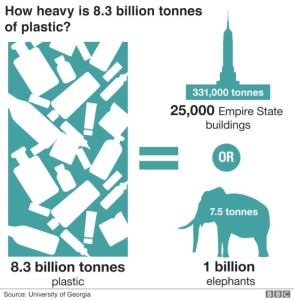Why are People Rushing to Join the Anti-plastics Bandwagon?
Aug 23rd, 2018 | By admin | Category: Consumption and WasteBy Candela Vázquez Asenjo, youth blogger for Transition Earth.
Since the 1950’s our world has made some of the biggest developments in history. We came from the disasters of the second world war to a world of peace with no precedence in the developed countries. However, even with this scenario of peace and comfort, some massive problems such as plastic pollution have arisen, affecting the whole planet.As John Vidal of the Guardian said, “Since we started engineering polymers to make plastic on a mass scale in the 1950s, this byproduct of the petrochemical industry, which uses about 6% of all the oil we extract a year, has spread to myriad manufacturing processes.”
It’s Cheap and Long-lasting
Plastic is one of the cheapest products on the market and also one of the most durable. And it has one of the biggest negative impacts on the environment. Its impacts are innumerable, yet interestingly it is a material that we still know little about. However, many people and scientists are starting to get more involved – this is the first time since the invention of plastic that so many scientists are studying this material and so many movements against it are appearing.
What could be the reason for this rise of awareness against plastics after almost 70 years, since the start of and dependence upon single-use plastics?
Not many bottom-top changes can be said to have created such a big difference. The anti-plastic movements have emerged from independent movements that have revealed the truth behind the use of single-use plastics and its consequences. These movements have expressed themselves through YouTube videos (such as a highly-watched one about the straw found inside the nose of a turtle), NGOs or other entities that have shown the reality of plastics and its alternatives, with an increasing number of scientific studies. However, it was not until the BBC documentary series called Blue Planet II aired that people became more conscious than ever about the dangers of plastics to our planet, health and society.
Additionally, many developing countries are suffering due to the severe environmental problems caused by plastics pollution. China, among other countries, has banned the introduction of more plastics in its country to incinerate or recycle. These countries are swimming in plastics, making the developed countries realize that they can no longer easily export their waste to other countries, resulting in more efforts to reduce its consumption.
More Plastics Than EverNevertheless, the amount of plastics that used to go to China now goes to other countries that have not banned the import of plastics. Still, there has been an improvement in the treatment and recycling of plastics, but this change does not mean much because today we are producing more plastics than ever.
Last year, a paper from the University of California, Santa Barbara, published in the journal Science Advances, made a global assessment of how much plastic has been manufactured. Scientists calculated that the total amount of virgin plastic ever produced stands at 8.3 billion tons, with half of it made in the past 13 years; just 30% of the historic production remains in use today. Of the discarded plastic, 9% has been recycled, 12% incinerated and 79% has gone to the landfill. Most surprising are the rates of recycling in 2014 – Europe at 30%, China at 25% and the US at a very low 9%.
The change towards a no-plastic reality is happening, driven not just from the developed countries but also from the developing ones. However, moving towards a non-plastic world has its disadvantages too. As we live in a time where our dependance on plastic is so great, there are few good existing alternatives to replace it that can meet everyone’s needs. One sector of our society who will be greatly affected by this change is, for example, people with physical disabilities who are not able to drink without a straw. Paper straws could be an option but they dilute very quickly for people who cannot drink that fast, and steel straws are difficult to use.
Additionally, even though many countries have started to implement straw bans, straws make up only a small amount of all plastics –just 4% of the total amount of plastic that we waste every year. Still, given that there are some estimates of 437 million to 8.3 billion plastic straws on coastlines throughout the world, there is an incentive to change, even if not a big change on its own.
Even though there is a long way to go until we approach a world where we could meet everyone’s needs and at the same time have a sustainable reality, our actions and thoughts are moving in the right direction. This can be seen in the unprecedented environmental actions that different governments around the planet are taking in banning plastic bags, straws and microbeads. So although there is much to be done, a big first step has been taken, being by far the hardest one.
Candela Vázquez Asenjo is a recent graduate of the University of Manchester, UK, with a degree in Environmental Management. She has also earned a law degree from Nebrija University in Spain. She is a social entrepreneur, with a focus on international environmental problems.

![[photo: Vberger/Wikimedia Commons]](http://populationgrowth.org/wp-content/uploads/2018/08/plastics-300x199.jpg)
![[photo: Ian Kirk, via Creative Commons]](http://populationgrowth.org/wp-content/uploads/2018/08/Litter_duck-300x200.jpg)
